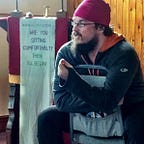Friction and the Social Model of Disability: From the Aggregation of Marginal Gains to Compounding Opportunity
Disabled people experience more low level frictions in life than others. Processes that many take for granted and can complete “automatically” or with little exertion can require disabled people to dig deep into their resource bank, and often leave them either unable to complete that task or too exhausted to complete further activities.
Disabled people also have fewer resources to begin.
This creates an obvious downward spiral, and is a major contributor to the unequal outcomes in life between disabled and non-disabled people, as reflected, for example, in the mental health income gap highlighted by the Money and Mental Health Policy Institute.
Removing frictions from disabled lives will have a massive impact on improving life opportunities and decreasing inequality — by increasing resource levels for enriching activities and increasing access to the everyday services and activities many people take for granted.
It will also create a compounding effect as we are able to use those resources to do more things, that in turn eliminate even more friction, further narrowing the opportunity gap and creating even more spare capacity.
“Big” interventions matter, but face massive political and, sadly, social (resentment) drag factors pulling against implementation.
Not enough attention is paid to the collective effect of removing tiny frictions. Indeed, the capacity some organisations have for removing massive clusters of such frictions means that financial institutions, local government, utilities providers, and retailers to name just a few have the potential to create positive impact in their customers’ lives disproportionately large in relation to the effort and outlay involved in implementing the friction removals.
This also benefits these organisations by increasing people’s capability of interacting with them, spending with them, and becoming ambassadors for them.
The benefit of focusing on small frictions is the simplicity of implementation and lack of political, financial, and social drag.
The disadvantage of focusing on them is the inability to draw a direct line of impact between an intervention and a better outcome, meaning there is no return on investment (ROI) metric, and as a result no incentive to continue, no dopamine feedback loop for organisations — because the impact is concentrated in the aggregation and the compounding process not any one part of either.
So
We need more focus on small frictions if we are to have a big impact on disabled people’s opportunities and widening the opportunity gap
But we also need a new approach to impact and metrics to remove the remaining drag on implementation.
Most important in that latter respect, when an organisation takes this step, we need to encourage it not to seek direct feedback about ROI and not to be discouraged from continuing or taking further action by the absence of such feedback.
For those organisations the key metric may well not be “how are these customers relating to me?” but rather “how have their lives changed?” The success of a price comparison site in making switching broadband supplier straightforward for someone with poor executive functioning might not be that they come back and use the same site to get a better insurance deal, but that they have time free to read to their child. And THAT success will at some point, even if we cannot inject a dye to find out where, feed back into and for the benefit of the system of which the organisation is a part.
